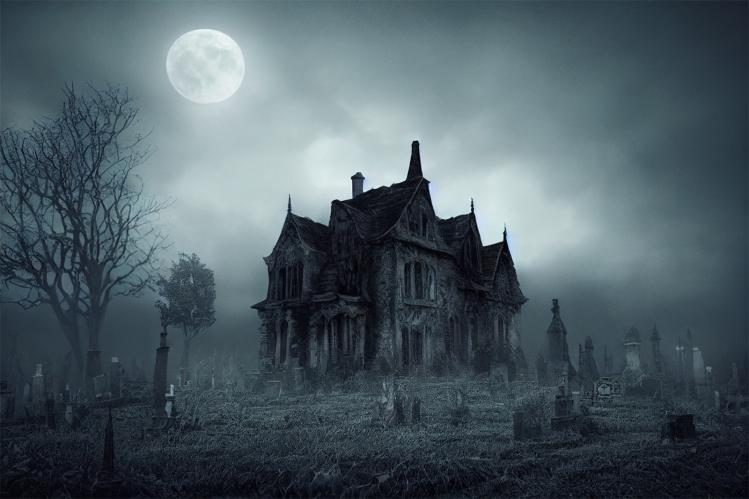
As a child, I was always perplexed by a line in Andy Williams’s holiday song “It’s the Most Wonderful Time of the Year.” What lunatic would tell “scary ghost stories” at Christmas? Why would someone sweep away the warmth of the holidays with the chill of a creepy tale?
It surprised me to learn that telling scary stories was once common at Christmastime, particularly in the Victorian era. Familiarity has desensitized us somewhat to Charles Dickens’s A Christmas Carol, but Ebenezer Scrooge’s ghostly visitations are actually quite frightening. (The original title of the story is a giveaway: A Christmas Carol. In Prose. Being a Ghost Story of Christmas.) Dickens intentionally brought back a tradition of telling ghost stories at Christmas that he feared was dying out. In prior centuries, the light and warmth of Christmas was tinged with fear for the lean months of winter. Before the modern conveniences that ensure a year-round food supply, the cold and dark of this time of year were a serious threat. What better way to quell our fears than to tame them into stories and draw our loved ones near by sharing them—say, around a fire, with a cup of mulled cider?
One of my favorite creepy tales is Joseph Sheridan Le Fanu’s 1872 novella Carmilla (Lanternfish Press, $14, 144 pp.), a vampire story that inspired Bram Stoker. The narrator, Laura, is a teenage girl who lives in a castle in the Austrian forest with her father. A carriage accident on the road outside the castle introduces her to the beautiful and charming Carmilla. The girls recognize each other from a dream they both had as children, and as Carmilla recuperates at the castle, the two become close friends. But—as they say—something is off. Carmilla makes sexual advances to Laura, and when she is rejected, her mood turns. She refuses to join Laura’s family for daily prayer. She sleeps late and is seen walking outside at night. Laura has dreams of a great, dark beast entering her room and biting her, and she finds two needle-thin marks on her neck. Meanwhile, girls in the nearby town are dying mysteriously. You might see where this is going. The Gothic and vampire tropes are familiar to us today, but the growing, inexorable sense of dread and horror that Le Fanu crafts as Laura uncovers Carmilla’s true nature always feels new.
One of my favorite things about a scary story is watching the characters adapt to a new reality. Something raw and undeniable imposes on them, and it strips them down to their true selves or transforms them into something else. A story I was pleased to discover this year was T. Kingfisher’s offbeat and unnerving tale What Moves the Dead (Tor Nightfire, $13.94, 176 pp.), a retelling of Edgar Allan Poe’s 1836 short story “The Fall of the House of Usher.” Set a few decades later in the fictional central-European country of Ruritania, What Moves the Dead is told from the perspective of Alex Easton—a former soldier and friend of Madeline and Roderick Usher—who travels to the crumbling Usher estate when they hear that Madeline is ill. (Kingfisher uses the pronouns that Easton’s native Gallacian designates for soldiers, ka/kan; in Gallacian, there are also specific pronouns for children, rocks, members of religious orders, and God.) Fungus covers the wall of the mansion. The tarn, or lake, is unnaturally still, reflecting ghostly stars that don’t appear in the sky above. The hares that populate the grounds move in a jerky, sickly way and show no fear of humans. Madeline is wasting away, but at night she roams the halls of the estate, speaking in strange voices. Kingfisher unspools a clever, creepy tale with a fresh narrator who wonders what counts as dead or alive, and what the difference might be anyway.
The scary stories I tend to prefer involve these romantic, old-fashioned frights—a spooky castle deep in the forest, a relatively unambiguous monster, a dark and stormy night far in the past. But one of my favorite ghost stories that I read year after year is very different: Neil Gaiman’s The Graveyard Book (HarperCollins, $10.22, 368 pp.). In an English town in the present day, a killer known as “the man Jack” murders three members of a family in their sleep. But the youngest child escapes and wanders to the town graveyard, where the ghosts who rest there take him in. They call him Nobody Owens—“Bod” for short—and grant him the “Freedom of the Graveyard” to keep him from the eyes of the living. As he grows up, Bod has many adventures involving the motley crew of ghosts from various eras of English history, the living members of the town, and the monster who lurks deep in an ancient grave. The tone is often whimsical, sometimes almost folklorish. But without warning, it can turn serious: Bod gets a taste of the cruel and confusing (living) adult world, and eventually he realizes that one day we will all be ghosts. All the while, Bod’s guardian Silas—a mysterious, supernatural creature atoning for his dark past—protects and educates Bod, teaching him to be good even when the world around him isn’t.
It is mid-October as I write about these creepy tales, and there are still a couple weeks left to embrace the spooky, the weird, and the mysterious. Every year I feel pressure to jettison the Halloween spirit on November 1 and focus on Christmas. But this year, perhaps I’ll look back to an older tradition that lets me hold on to the ghostly a little longer.

